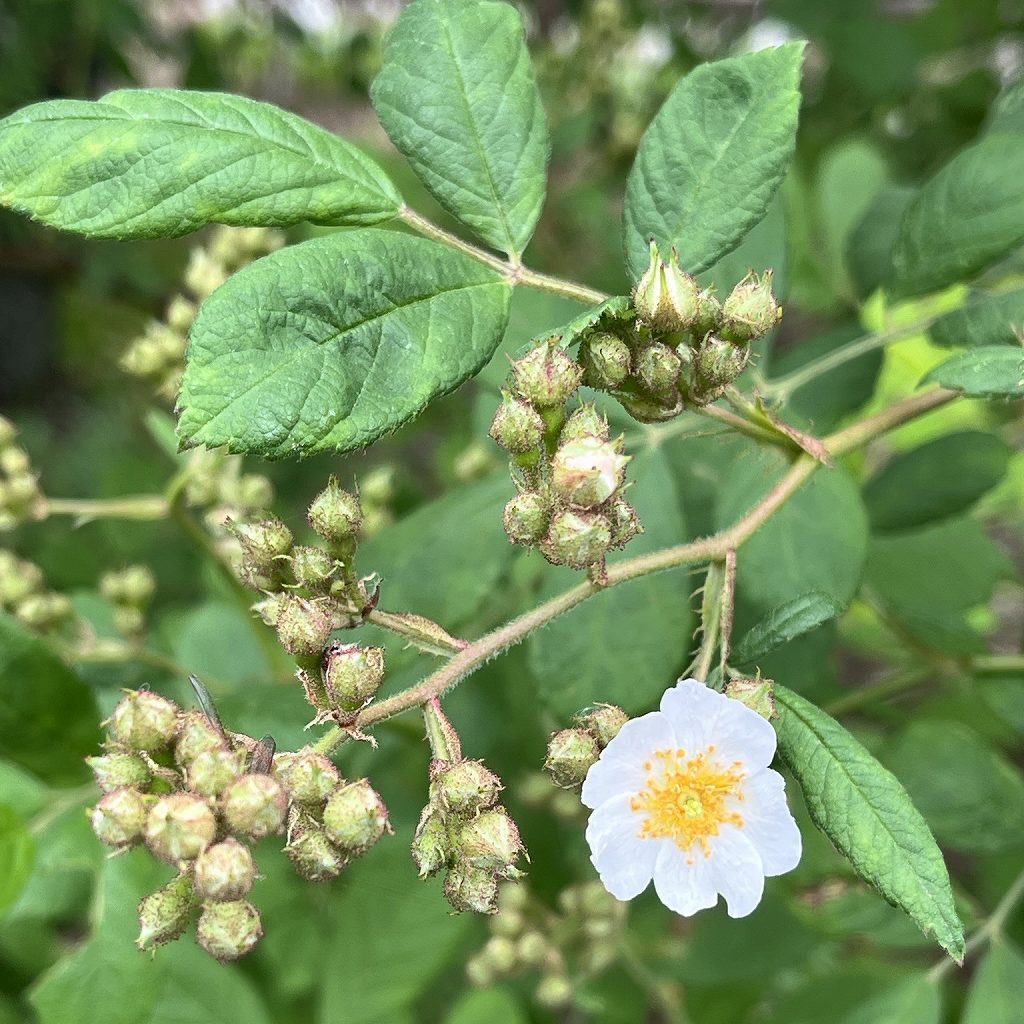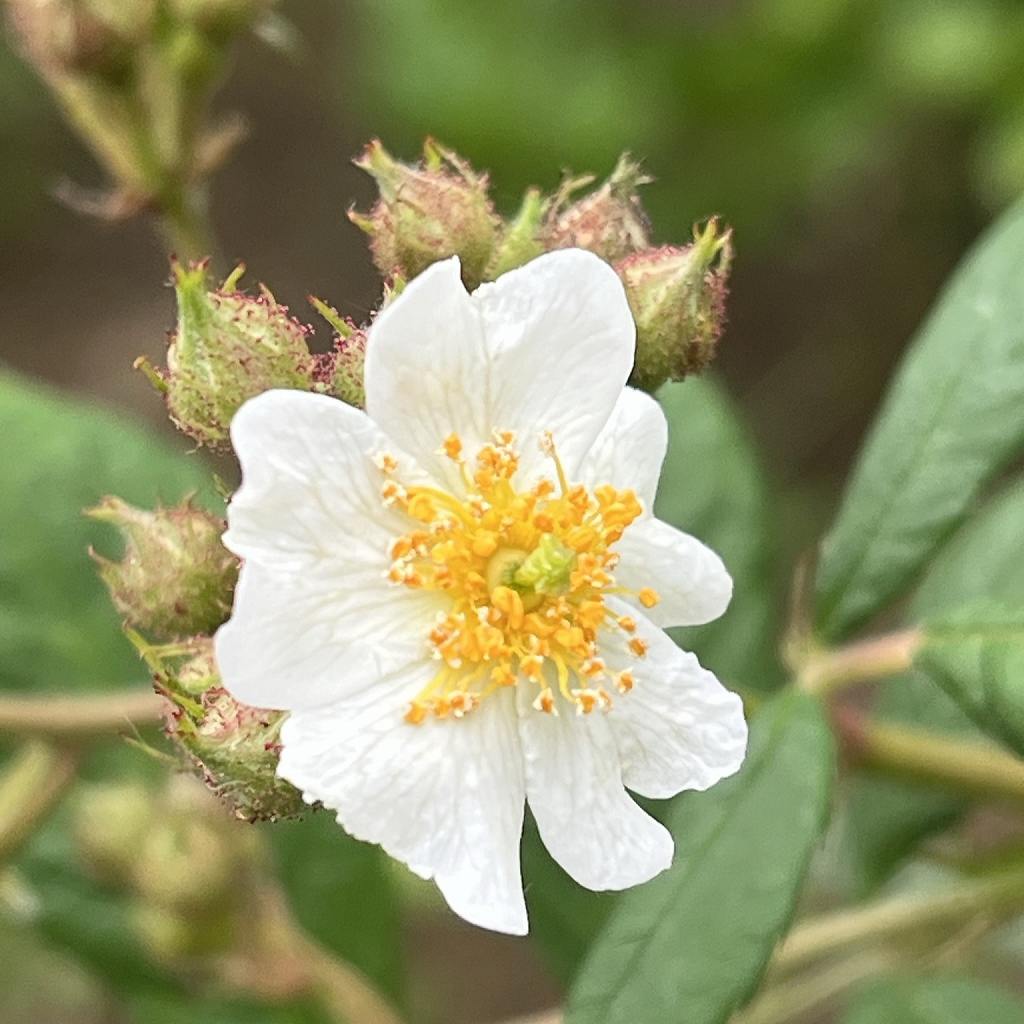ノイバラの花は白色の花弁が5枚。枝先で次々咲き広がり、芳香を放ちます。花後は萼筒が肥大して偽果を形成。赤色に熟して甘く香ります。
Multiflora Rose flower has 5 white petals. It blooms one after another at the tip of the branch and emits a fragrance. After flowering, the calyx tube enlarges and forms a false fruit. Ripe red and sweetly fragrant.
【仮名】ノイバラ, ノバラ
【和名】野茨, 野薔薇
【英名】Multiflora Rose, Japanese Rose
【学名】Rosa multiflora
【誕生】04/ 28, 05/ 30
【開花】04, 05, 06月
【花色】White



ノイバラ
ノイバラの概要
ノイバラはバラ科の落葉低木。日本では北海道から本州、四国、九州まで、国外では朝鮮半島、中国に分布しています。名前の由来は普通の野原に自生し、棘のある低木を意味する「茨」だから。ラテン語の属名ロサは「薔薇」、種小名ムルチフローラは「花が多い」という意味です。
ノイバラの姿形
ノイバラの枝は蔓性で盛んに分岐。鋭い棘があり、高い木に絡みつきながら這い上がります。葉は羽根状で互生。小葉は楕円形で葉縁に鋭い鋸歯が入ります。花は白色の花弁が5枚。枝先で咲き広がり、芳香を放ちます。花後は萼筒が肥大して偽果を形成。赤色に熟して甘く香ります。
ノイバラの利用
ノイバラの偽果はマルチフロリンやクエルセチンなどのフラボノイド配糖体を含有。完熟前に天日に干し、生薬「営実」として、便秘の解消や利尿などに用いられました。民間療法では外用薬として、おできやにきびなどに。花は健胃や止血に、根は下痢や血便などに用いられました。
ノイバラの近縁
ノイバラの近縁「照葉野茨」は、同じように芳香のある白色の5弁花を枝先に咲かせ、偽果が赤色に熟します。名前の通り、葉の表面に光沢があり、蔓が地面を這うように伸びるので「這茨」という別名も。開花が1カ月ほど遅く、花数が少ないものの、花冠が一回り大きくなります。
ノイバラの栽培
ノイバラはありふれた雑木なので、あえて栽培されることもありませんでしたが、その耐寒性と多花性を活かし、昔から栽培種の台木に用いられます。さらに交配用の原種にも用いられ、栽培種に房咲き性を付与。今では、それ自体の趣が評価され、庭に植えられるようになりました。
Multiflora Rose
Multiflora Rose is a deciduous shrub of the Rosaceae family. In Japan, it is distributed from Hokkaido to Honshu, Shikoku, and Kyushu, and outside of Japan, it is distributed in the Korean Peninsula and China. Japanese name means that a shrub with thorns grows wild in ordinary fields. The Latin genus name Rosa means “rose” and the species name multiflora means “many flowers”.
The branches of Multiflora Rose are vines and branch profusely. It has sharp thorns and climbs up while entwining itself on tall trees. The leaves are wing-shaped and alternate. The leaflets are elliptical with sharp serrated edges. The flowers have five white petals. It blooms at the tip of the branches and emits a fragrance. After flowering, the calyx tube enlarges and forms a false fruit. Ripe red and sweetly fragrant.
The false fruit of Multiflora Rose contains flavonoid glycosides such as multiflorin and quercetin. It was dried in the sun before it reached full maturity and was used as a herbal medicine to relieve constipation and diuretic. In folk medicine, it is used as an external medicine for boils and acne. The flowers were used for stomachic and hemostasis, and the roots were used for diarrhea and bloody stools.
A close relative of Multiflora Rose, “Rosa luciae” has similarly fragrant white five-petaled flowers blooming at the tips of its branches, and the false fruits ripen to a red color. The surface of the leaves is glossy, and the vines grow like crawling on the ground. Although flowering is about a month late and flowers are few, the corolla is one size larger.
Because it is a common miscellaneous tree, it was never cultivated, but it has been used as a rootstock for cultivated species before, taking advantage of its cold resistance and multi-flowered properties. In addition, it is also used as an original seed for crossbreeding, giving the cultivated species the ability to bloom in clusters. Today, it is appreciated for its taste and is planted in gardens.


